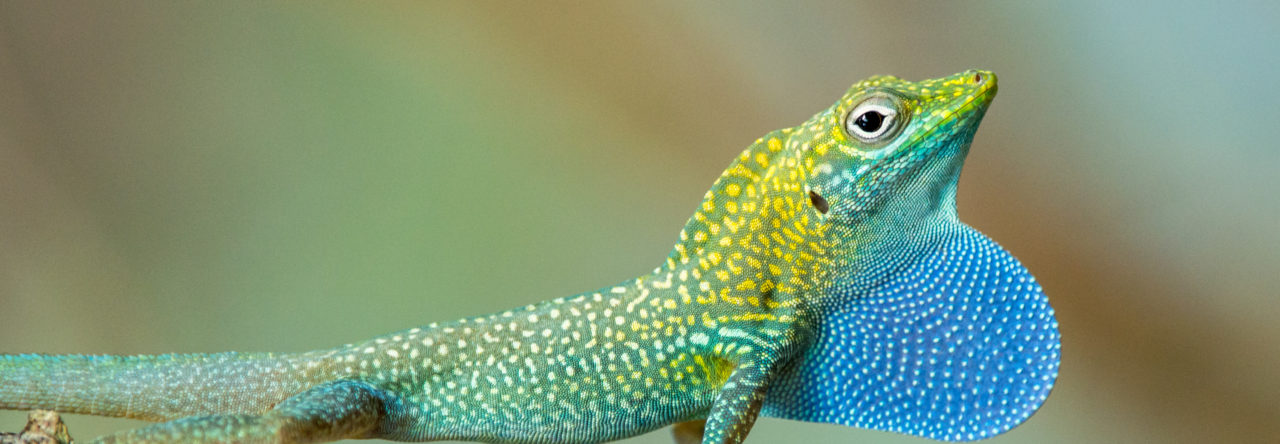 It’s an old story: a Cuban émigré arrives in Florida, thrives and then sends out roots, in the process becoming completely Americanized. I refer, of course, to the green anole, Anolis carolinensis, derived from grand-daddy porcatus in Cuba. But the exact story of carolinensis‘s spread–when, by what routes, where–is still unclear. Two years ago, a pair of papers reported interpretations based on sequences of mitochondrial DNA, revealing a somewhat complicated history of green anole diaspora. Now, in a recent paper in Genetica, Tollis and Boissinot revisit this question, bringing to bear the power of a multi-locus, nuclear gene sequencing effort. Their results lead to a simpler, more satisfying story, and suggest that we need to be wary of placing too much faith in phylogeographic/evolutionary scenarios derived from mitochondrial DNA.
It’s an old story: a Cuban émigré arrives in Florida, thrives and then sends out roots, in the process becoming completely Americanized. I refer, of course, to the green anole, Anolis carolinensis, derived from grand-daddy porcatus in Cuba. But the exact story of carolinensis‘s spread–when, by what routes, where–is still unclear. Two years ago, a pair of papers reported interpretations based on sequences of mitochondrial DNA, revealing a somewhat complicated history of green anole diaspora. Now, in a recent paper in Genetica, Tollis and Boissinot revisit this question, bringing to bear the power of a multi-locus, nuclear gene sequencing effort. Their results lead to a simpler, more satisfying story, and suggest that we need to be wary of placing too much faith in phylogeographic/evolutionary scenarios derived from mitochondrial DNA.
Here’s the tail end of their abstract:
“We find that all demographic events occurred during or after the Upper Pliocene and suggest that green anole diversification was driven by population divergence on interglacial island refugia in Florida during the Lower Pleistocene, while the region was often separated from continental North America. When Florida reconnected to the mainland, two separate dispersal events led to the expansion of green anole populations across the Atlantic Seaboard and Gulf Coastal Plain.”
Their inferred evolutionary relationships are portrayed above, and their biogeographic scenario below.
- Evolution in Real Time on Lizard Island - March 23, 2025
- Spider Snags Adult Anolis osa - March 22, 2025
- An Homage to the Green Anoles of New Orleans - March 21, 2025



Skip Lazell
Ought to check populations in the Keys, especially Lower Keys like Big Pine….
Skip
Anthony Geneva
Anything on the Keys now is likely the result of a secondary range expansion from peninsular Florida since those islands were inundated for much of the possible colonization window: http://sofia.usgs.gov/publications/papers/interplay_platform/images/fig2x.gif
Marc Tollis
We didn’t have samples from the Keys to test with nuclear DNA, but GenBank has mtDNA sequences and they fall squarely in one of the more wide-ranging South Florida clades, so I think Anthony is right.
Don Lyman
I still wonder why carolinensis hasn’t radiated like anole species that colonized Caribbean islands.
Skip Lazell
Lack of speciation probably reflects lack of sufficiently prolonged isolation. Glacial and inter-glacial sealevel fluctuations effectively fragment potential islands on Caribbean Banks but the separate Banks are not connected. All Florida is on the same Bank: insufficient isolation time. Cuba is on a different Bank: that worked!
Skip
Robert Sprackland
Tried the link to the original paper but was sent to an error page. Could you send another link? Thanks.
Jonathan Losos
Link corrected!